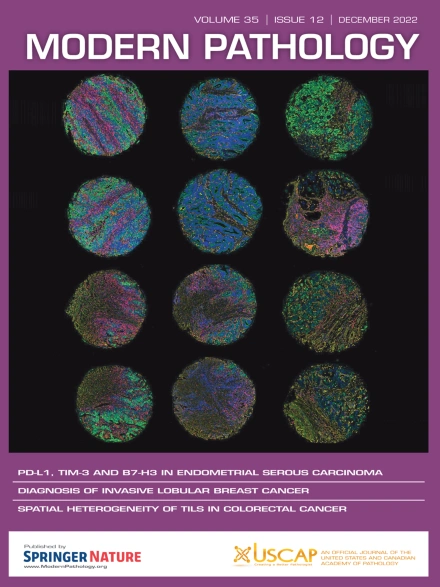MYC阳性和MYC阴性高级别b细胞淋巴瘤11q畸变与其他MYC重排侵袭性淋巴瘤的细胞基因组学和临床病理学比较
IF 5.5
1区 医学
Q1 PATHOLOGY
引用次数: 0
摘要
根据2022年世界卫生组织分类,高级别b细胞淋巴瘤伴11q畸变(HGBCL-11q)是一种myc阴性淋巴瘤,11q重复和末端缺失是该肿瘤的特异性染色体畸变。然而,越来越多的报道违背了这一定义,描述了11q畸变和MYC重排共同发生的病例(HGBCL-11q,MYCR)。这项研究有两个目的。首先,比较独特的HGBCL-11q,MYCR组9例与26例HGBCL-11q在染色体、突变和临床病理水平上的差异。第二个目的是研究新的HGBCL-11q,MYCR组与HGBCL-11q和其他2种密切相关的myc阳性侵袭性淋巴瘤亚型的关系:Burkitt淋巴瘤(BL) (n = 17)和HGBCL,未与MYCR指定(n = 10)。遗传结果通过经典细胞遗传学,荧光原位杂交,微阵列和全外显子组测序获得。在流式细胞术(FCM)的平行组织病理学/免疫组化分析(HP/IHC),结合临床表现和治疗结果,提出。我们的研究结果表明,HGBCL-11q,MYCR作为一个独立的病理实体存在,在细胞遗传学,分子和临床病理水平上与BL和HGBCL-11q不同,尽管它包含两种淋巴瘤亚型的共同特征。BL的共同特征包括:MYCR伴免疫球蛋白(Ig)基因,继发性染色体畸变模式,如dup(1q), del(17p), MYC和CCND3大量突变。其他BL的特征包括:结外腹部的频繁表现、形态学、生发中心b细胞样起源细胞,流式细胞术检测MYC(+)/LMO2(-)等免疫表型特征:CD45(+)较弱,CD43(+)和CD44(-)表达较多,仅表达IgD和IgM重链,CD38(+)较高过表达,与FCM评估的MYCR相关。与HGBCL-11q的相似性包括存在11q畸变,存在DDX3X、ETS1、GNA13、NFRKB和KMT2D,缺乏TCF3和ID3突变。此外,观察到频繁的淋巴结和扁桃体表现、形态学、生发中心b细胞样细胞起源和免疫表型特征,包括使用流式细胞仪测量的CD56(+)表达,这些特征与11q上的NCAM复制/扩增有关,其发病机制与eb病毒感染无关。HGBCL-11q、MYCR的显著染色体变化是3q29的获得或扩增。我们的HGBCL-11q、MYCR患者队列与HGBCL-11q和BL患者的无复发生存率相似,如果接受BL指导方案治疗。本文章由计算机程序翻译,如有差异,请以英文原文为准。
Cytogenomic and Clinicopathologic Comparison of MYC-Positive and MYC-Negative High-Grade B-Cell Lymphoma With 11q Aberration in the Context of Other Aggressive Lymphomas With MYC Rearrangement
According to the 2022 World Health Organization Classification, high-grade B-cell lymphoma with 11q aberration (HGBCL-11q) is a MYC-negative lymphoma with 11q duplication and terminal deletion as specific chromosomal aberrations for this neoplasm. However, there is a growing number of reports defying this definition, describing cases with the co-occurrence of 11q aberration and MYC rearrangement (HGBCL-11q,MYCR). This research has 2 aims. First, to compare the unique HGBCL-11q,MYCR group of 9 cases with 26 HGBCL-11q cases on chromosomal, mutational, and clinicopathological levels. The second objective was to investigate the association of the new HGBCL-11q,MYCR group with HGBCL-11q and 2 other closely related MYC-positive aggressive lymphoma subtypes: Burkitt lymphoma (BL) (n = 17) and HGBCL, not otherwise specified with MYCR (n = 10). Genetic results were obtained by classical cytogenetics, fluorescence in situ hybridization, microarrays, and whole exome sequencing. In parallel histopathologic/immunohistochemical analyses (HP/IHC)with flow cytometry (FCM), in conjunction with clinical presentation and treatment outcomes, are presented. Our findings reveal that HGBCL-11q,MYCR exists as an independent nosologic entity, distinct from BL and HGBCL-11q at the cytogenetic, molecular, and clinicopathological levels, although it contains common features of both lymphoma subtypes. Common features with BL include following: MYCR with the immunoglobulin (Ig) genes, patterns of secondary chromosomal aberrations like dup(1q), del(17p), and high number of MYC and CCND3 mutations. Other BL features are: frequent extranodal abdominal presentation, morphology, germinal center B-cell-like cell of origin determined by IHC and FCM, immunophenotypical features such as MYC(+)/LMO2(–) detected by following flow cytometric features: CD45(+)weaker, more cases with CD43(+) and CD44(–) expression, only expression of IgD and IgM heavy chain, and CD38(+)higher overexpression, which correlates with MYCR assessed by FCM. Similarity to HGBCL-11q includes the existence of 11q aberration, presence of DDX3X, ETS1, GNA13, NFRKB, and KMT2D, and the lack of TCF3 and ID3 mutations. Additionally, frequent nodal and tonsillar presentation, morphology, germinal center B-cell-like cell of origin, and immunophenotypical features, including CD56(+) expression measured using FCM, are observed, which are associated with NCAM duplication/amplification on 11q, and pathogenesis not associated with Epstein-Barr virus infection. The distinctive chromosomal change of HGBCL-11q,MYCR was the gain or amplification of 3q29. Our cohort of patients with HGBCL-11q,MYCR had similar relapse-free survival to that of patients with HGBCL-11q and BL, if treated with BL-directed regimens.
求助全文
通过发布文献求助,成功后即可免费获取论文全文。
去求助
来源期刊

Modern Pathology
医学-病理学
CiteScore
14.30
自引率
2.70%
发文量
174
审稿时长
18 days
期刊介绍:
Modern Pathology, an international journal under the ownership of The United States & Canadian Academy of Pathology (USCAP), serves as an authoritative platform for publishing top-tier clinical and translational research studies in pathology.
Original manuscripts are the primary focus of Modern Pathology, complemented by impactful editorials, reviews, and practice guidelines covering all facets of precision diagnostics in human pathology. The journal's scope includes advancements in molecular diagnostics and genomic classifications of diseases, breakthroughs in immune-oncology, computational science, applied bioinformatics, and digital pathology.
 求助内容:
求助内容: 应助结果提醒方式:
应助结果提醒方式:


